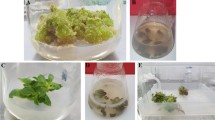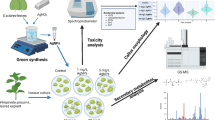Abstract
Porphyran, a sulfated galactan, is the main cellular polysaccharide in the marine red alga Pyropia yezoensis. In this study, oligo-porphyrans, obtained by acid hydrolysis of porphyran, were investigated for their H2O2-inducing abilities in the defense responses of P. yezoensis. Oligo-porphyrans with average molecular weights (MWs) lower than 1.43 kDa had H2O2-inducing abilities. In contrast, oligo-porphyrans with average MWs of 6.12 kDa triggered no response. The active oligo-porphyrans were fractioned by anion-exchange chromatography. We found that two distinct mechanisms might be involved in the oligo-porphyran-induced H2O2 release in P. yezoensis. Mixtures of mono-sulfated oligo-galactans with degrees of polymerization (DPs) ranging from 1 to 3 might induce the response through the oxidation of cellular oligosaccharides, which enable P. yezoensis to resist rotting caused by dense incubation. Mixtures of oligo-porphyrans, consisting of 4 ~ 7 monosaccharide residues and 2 ~ 3 sulfate groups, might induce the generation of H2O2 by activation of NADPH oxidase, leading to an oxidative burst in P. yezoensis. The elicitor activity of oligo-porphyrans thus depends on their molecular size.









Similar content being viewed by others
References
Alvarez ME, Pennell RI, Meijer PJ, Ishikawa A, Dixon RA, Lamb C (1998) Reactive oxygen intermediates mediate a systemic signal network in the establishment of plant immunity. Cell 92:773–784
Baureithel K, Felix G, Boller T (1994) Specific, high-affinity binding of chitin fragments to tomato cells and membranes, competitive inhibition of binding by derivatives of chitooligosaccharides and a nod factor of Rhizobium. J Biol Chem 269:17931–17938
Boller T, Felix G (2009) A renaissance of elicitors: Perception of microbe-associated molecular patterns and danger signals by pattern-recognition receptors. Annu Rev Plant Biol 60:379–406
Bolwell GP, Wojtaszek P (1997) Mechanisms for the generation of reactive oxygen species in plant defence—a broad perspective. Physiol Mol Plant Pathol 51:347–366
Bouarab K, Potin P, Correa J, Kloareg B (1999) Sulfated oligosaccharides mediate the interaction between a marine red alga and its green algal pathogenic endophyte. Plant Cell 11:1635–1650
Darvill A, Augur C, Bergmann C, Carlson RW, Cheong JJ, Eberhard S, Hahn MG, Lo VM, Marfa V, Meyer B, Mohnen D, Oneill MA, Spiro MD, Vanhalbeek H, York WS, Albersheim P (1992) Oligosaccharins-oligosaccharides that regulate growth, development and defense responses in plants. Glycobiology 2:181–198
Dubois M, Gilles KA, Hamilton JK, Rebers PA, Smith F (1956) Colorimetric method for determination of sugars and related substances. Anal Chem 28:350–356
Felix G, Regenass M, Boller T (1993) Specific perception of subnanomolar of chitin fragments by tomato cells-induction of extracellular alkalinization, changes in protein-phosphorylation, and establishment of a refractory state. Plant J 4:307–316
Hahn MG (1996) Microbial elicitors and their receptors in plants. Annu Rev Phytopathol 34:387–412
Kupper FC, Muller DG, Peters AF, Kloareg B, Potin P (2002) Oligoalginate recognition and oxidative burst play a key role in natural and induced resistance of sporophytes of Laminariales. J Chem Ecol 28:2057–2081
Miller WL, Kester DR (1988) Hydrogen peroxide measurement in seawater by (p-hydroxyphenyl)acetic acid dimerization. Anal Chem 60:2711–2715
Orozco-Cardenas ML, Narvaez-Vasquez J, Ryan CA (2001) Hydrogen peroxide acts as a second messenger for the induction of defense genes in tomato plants in response to wounding, systemin, and methyl jasmonate. Plant Cell 13:179–191
Potin P, Bouarab K, Kupper F, Kloareg B (1999) Oligosaccharide recognition signals and defence reactions in marine plant-microbe interactions. Curr Opin Microbiol 2:276–283
Shibuya N, Minami E (2001) Oligosaccharide signalling for defence responses in plant. Physiol Mol Plant Pathol 59:223–233
Torres MA, Jones JDG, Dangl JL (2006) Reactive oxygen species signaling in response to pathogens. Plant Physiol 141:373–378
Uppalapati SR, Fujita Y (2000) Carbohydrate regulation of attachment, encystment, and appressorium formation by Pythium porphyrae (Oomycota) zoospores on Porphyra yezoensis (Rhodophyta). J Phycol 36:359–366
Vera J, Castro J, Gonzalez A, Moenne A (2011) Seaweed polysaccharides and derived oligosaccharides stimulate defense responses and protection against pathogens in plants. Mar Drugs 9:2514–2525
Vorwerk S, Somerville S, Somerville C (2004) The role of plant cell wall polysaccharide composition in disease resistance. Trends Plant Sci 9:203–209
Weinberger F, Friedlander M (2000) Endogenous and exogenous elicitors of a hypersensitive response in Gracilaria conferta (Rhodophyta). J Appl Phycol 12:139–145
Weinberger F, Friedlander M, Hoppe HG (1999) Oligoagars elicit a physiological response in Gracilaria conferta (Rhodophyta). J Phycol 35:747–755
Weinberger F, Leonardi P, Miravalles A, Correa JA, Lion U, Kloareg B, Potin P (2005) Dissection of two distinct defense-related responses to agar oligosaccharides in Gracilaria chilensis (Rhodophyta) and Gracilaria conferta (Rhodophyta). J Phycol 41:863–873
Weinberger F, Coquempot B, Forner S, Morin P, Kloareg B, Potin P (2007) Different regulation of haloperoxidation during agar oligosaccharide-activated defence mechanisms in two related red algae, Gracilaria sp and Gracilaria chilensis. J Exp Bot 58:4365–4372
Weinberger F, Guillemin ML, Destombe C, Valero M, Faugeron S, Correa JA, Pohnert G, Pehlke C, Kloareg B, Potin P (2010) Defense evolution in the Gracilariacea(Rhodophyta): Substrate-regulated oxidation of agar oligosaccharides is more ancient than the oligoagar-activated oxidative burst. J Phycol 46:958–968
Yamaguchi T, Ito Y, Shibuya N (2000) Oligosaccharide elicitors and their receptors for plant defense responses. Trends Glycosci Glycotechnol 12:113–120
Zhang QB, Qi HM, Zhao TT, Deslandes E, Ismaeli NM, Molloy F, Critchley AT (2005) Chemical characteristics of a polysaccharide from Porphyra capensis (Rhodophyta). Carbohydr Res 340:2447–2450
Acknowledgments
This work was supported by the Innovative Key Project of the Chinese Academy of Sciences (KZCX2-YW-QN204); National Key Technology Research & Development Program (2013BAB01B01); Special Fund for Marine Scientific Research in the Public Interest (201405040); Shandong Province Science and Technology Development Project (2014GHY115017); and Applied Research Projects of Nantong Municipal (BK2013011). The authors thank Prof. Zhien Li and Zuhong Xu (Institute of Oceanology, Chinese Academy of Sciences) for their helpful assistance in the experiments.
Author information
Authors and Affiliations
Corresponding author
Rights and permissions
About this article
Cite this article
Hou, Y., Wang, J., Simerly, T. et al. Hydrogen peroxide released from Pyropia yezoensis induced by oligo-porphyrans: Mechanisms and effect. J Appl Phycol 27, 1639–1649 (2015). https://doi.org/10.1007/s10811-014-0471-7
Received:
Revised:
Accepted:
Published:
Issue Date:
DOI: https://doi.org/10.1007/s10811-014-0471-7




